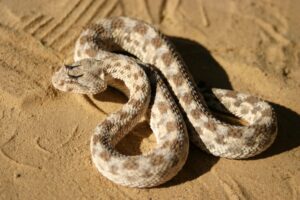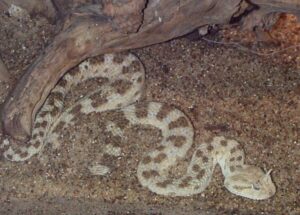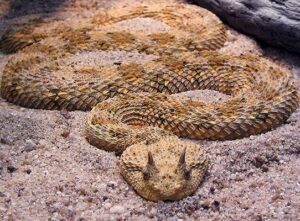Horned vipers are venomous vipers found in the deserts of North Africa and parts of the Arabian Peninsula and the Levant. They have adapted themselves to live in deserts. One such adaptation is filling their scales with morning dew and using it as a water source later on.
These vipers possess two horns on top of their eyes. However, hornless individuals of this species also exist. They are also called Saharan horned viper, desert horned viper, desert sidewinding horned viper, horned s, North African horned viper, African desert horned viper, asp and horned viper, and greater cerastes.
These snakes are solitary and nocturnal species that move by sidewinding. While moving, they press their bodies into the soil and leave behind full-body impressions.
Scientific Classifications
- Suborder:Serpentes
- Family:Viperidae
- Genus:Cerastes
- Species:C. cerastes
Conservation Status
Subspecies
The horned viper has three subspecies:
- Algerian Horned Viper (Cerastes ceraste mutila)
- Egyptian Horned Viper (Cerastes ceraste karlhartli)
- Cerastes ceraste hoofieni
Description
Size
The average length of these vipers is 24 inches (60 cm). Females are generally larger than males.
Color and Appearance
These snakes can be pale grey, yellowish, reddish, pinkish, or pale brown ground color, depending on the substrate color of their location. They have a series of dark, semi-rectangular blotches on the dorsal side of their body. Sometimes, these blotches can be fused into crossbars.
Their most distinguishing feature is a pair of horns above their prominent eyes. The size of the horns varies, and they can be absent in some rare individuals.
The upper side of the body is filled with a series of semi-rectangular, dark blotches, which may or may not be combined to form crossbars. They have a white belly and a thin tail with a black tip.
Certain sexual dimorphisms are observed in these species. The males have larger eyes and heads than the females.
Are They Dangerous to Humans
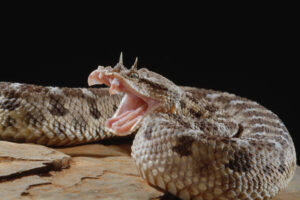
These are poisonous snakes with a high venom yield. Usually, they have a calm temperament but will attack if disturbed.
The venom of horned vipers has an LD50 value of 0.4 mg/kg intravenously and 3.0 mg/kg subcutaneously. They can yield 19–100 mg of dried venom, where an estimated lethal dose for humans is 40-50 mg. The presence of a high phospholipase A2 content causes cardiotoxicity and myotoxicity.
The action of their venom is similar to that of Echis venom. The symptoms of their bites are hemorrhage, necrosis, swelling, vomiting, nausea, and haematuria.
Horned Viper at a Glance
Distribution
Horned vipers are commonly found in Iraq. They also occur in Israel, Jordan, Kuwait, Saudi Arabia, Syria, Yemen, and parts of North Africa, including Egypt, Libya, and Sudan.
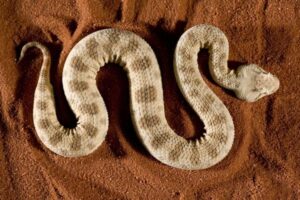
Habitat
These snakes inhabit dry, sandy areas with sparse rock outcroppings, avoiding coarse sand. They can also be found occasionally near oases and up to an altitude of 4900 feet (1500 m). They prefer to live in cooler regions with an average annual temperature of 20 degrees Celsius.
Lifespan
The horned viper can live up to 14 years in captivity, and its lifespan in the wild is unknown.
Predators
The predators of horned vipers are Nile monitors, honey badgers, and various feral wild cats. If threatened, they form a C-shaped posture and rapidly rub their coils together, producing a rasping sound as they cannot hiss. When further approached, they strike rapidly at the perceived threat.
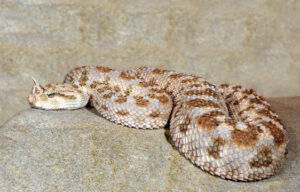
Diet
Horned vipers are ambush predators who lie hidden in sands near rocks or under vegetation. When they spot prey, they strike quickly, inject their venom, and hold on to them until they die. Their primary diet consists of lizards, but they occasionally eat rodents and birds.
Reproduction
Horned vipers are egg-laying species. Their mating season is in April. Mating happens while they are buried in the sand. They can lay 8-23 eggs that hatch after an incubation period of 50–80 days. The eggs are laid under rocks and in empty rodent burrows. The hatchlings are about 5-6 inches (12-15 cm) in total length and are born independent. Juveniles gain reproductive maturity at the age of two years.
Similar Species
Arabian Horned Viper
They look like horned vipers but have smaller heads compared to them. Horned vipers also have a greater frequency of horned individuals than Arabian horned vipers.
Care Sheet
Size of Enclosure: Horned vipers require a 2.6 X 1.3 X 1.0 feet terrarium.
Substrate: These vipers are from desert regions. So the substrate required to keep them in an enclosure would be a mix of sand and soil, good dry soil, and bark and wood chips.
Humidity: These vipers require a medium humidity level. The humidity of their terrarium is mainly kept at 50-60% and seldom up to 70%.
Temperature: They can be kept at a room temperature of 20 – 30⁰ C.
Lighting: These snakes need a heating device in their enclosure to keep them heated. Reptile heating lanterns or some other accessories should be installed in their terrarium.
Feeding: In confinement, these vipers are fed small vermin and dead rodents.
Source
earth.com, whozoo.org, csmonitor.com, t3.ftcdn.net, art-prints-on-demand.com

